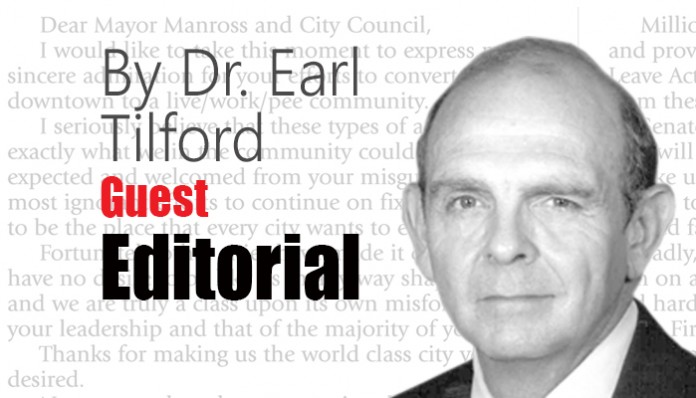“Heck, I reckon you wouldn’t even be human beings if you didn’t have some pretty strong personal feelings about nuclear combat.” —King Kong, Major, USAF (from Dr. Strangelove)
In 1964, when I was a college freshman, all healthy male students without prior military service were required to take two years of a basic Air Force Reserve Officer Training Course (AFROTC). The Stanley Kubrick movie. Dr. Strangelove: Or How I Learned to Stop Worrying and Love the Bomb, was new. This child of the 1960s now in his 70s has two satirical movies committed to memory: Dr. Strangelove and Animal House.
What makes satire work is its relationship to truths like having “some pretty strong personal emotions about nuclear combat.” My personal emotions on the subject evolved from a love of Russian history acquired during my undergraduate days. My artist mother surprised me on Christmas Day 1967 with an oil painting of Saint Basil’s Cathedral in Moscow’s Red Square. Four years later, that painting hung in the Strategic Air Command’s (SAC) Warning Center three stories underground at SAC headquarters; it was set behind a picture frame so it appeared the Intelligence Early Warning (INEW) shop looked out on Red Square. INEW was tasked with making the initial decision as to whether or not the USSR had launched a nuclear attack. If we did give the green light, within minutes the president would “push the button.”
Relax, it’s not a button, and it’s not that simple to launch a retaliatory strike. Nevertheless, within 10 to 15 minutes after determining an attack was underway, Minuteman missiles would be headed for targets in the Soviet Union and Warsaw Pact countries of Eastern Europe. Bombers based in the continental United States would also be on their way—just ahead of Soviet missiles hitting their bases. The Cold War reality was that there never was a “hare trigger” or a “nuclear button.”
Only once in SAC’s history was the United States close to “nuclear combat.” That was October 1962 during the crisis over Soviet medium-range missiles and short-range IL-28 bombers in Cuba. In reality, SAC and our counterparts in the Soviet Long Range Air Force and Strategic Rocket Forces took the prospect of nuclear war quite seriously. Deterrence demanded we do so. For deterrence to work, “the other” must be absolutely certain of the will and ability of the opposing force to “push the button.”
Facing that reality was surreal. From 1954, when the USSR first possessed bombers able to strike the United States, until 1969 when the USSR reached rough nuclear parity with the West, American nuclear strategy operated under the concept of massive retaliation. After 1969, the strategy was Mutual Assured Destruction (MAD). In short, if “the balloon went up” we were going to nuke the Soviet Union until it glowed. Within the rubric of MAD, the Soviets would have responded in kind. That’s what made deterrence work then—and now.
The Kennedy administration fostered the concept of “flexible response,” and SAC accommodated. Nevertheless, the nuclear war plan still envisioned rapid escalation to full-scale retaliation. The Soviet war plan was to “slime” the West almost immediately.
In June 1961, President Kennedy left his Vienna meeting with Soviet Premier Nikita Khrushchev convinced the United States would be at war within six months. After the USSR erected the Berlin Wall, Kennedy asked for a “First Strike Plan.” SAC already had one. Fifty-five B-52s would drop 80 nuclear bombs on Soviet long-range missile sites and bomber bases. While this would annihilate an estimated 80 to 90 percent of Soviet nuclear capability, the United States still would retain enough nuclear striking power to obliterate the USSR should it attempt a much degraded and uncoordinated counter strike.
Since Soviet missile and bomber bases were in sparsely populated areas, the estimated human cost was under one million, primarily military personnel. Some argued the USSR, after suffering 20 to 30 million dead during World War II, would be unlikely to risk nuclear annihilation over one million more. Kennedy decided against a first strike. In 1961, JFK had a really “Big Button.”
If President Donald Trump’s tough talk makes it clear to would-be North Korean nuclear mogul Kim Jung-un that he is, indeed, risking a “rain of fire,” so be it. Deterrence works only when potential adversaries fear the consequences. Everyone able to invoke “nuclear combat” has to have not only “pretty strong emotions” but also an absolute logical certainty of what that involves.
There is, however, a mechanism for launching a nuclear war. It is both complex and efficient. That we have never had to use it testifies to its effectiveness. President Trump is the only person who can launch a nuclear strike. He is communicating clearly and effectively with people who matter in Pyongyang, Tehran, Moscow, and Beijing.
—Dr. Earl Tilford is a military historian and fellow for the Middle East & terrorism with The Center for Vision & Values at Grove City College.





